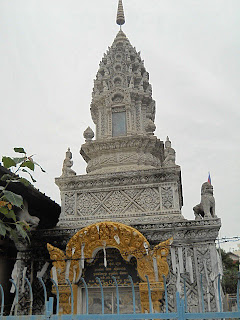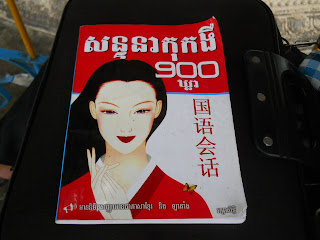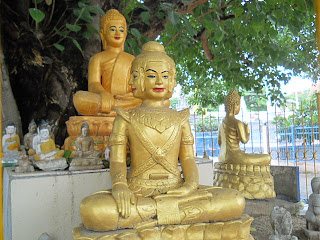 Directly across Phnom Penh's Olympic Stadium lies Wat Moha Montrei along Sihanouk Boulevard.
Directly across Phnom Penh's Olympic Stadium lies Wat Moha Montrei along Sihanouk Boulevard.There is a pedestrian crossing near the traffic light junction.
The temple's entrance is at Street 163 while another one is at Street 173 which is near the Psar Olympic market.
Hotel Samreth Olympic is just in front of the temple at Street 163.
The room rates here starts from USD25.
Behind this hotel at Street 310 is Guesthouse Kiyo Tel:(855)23 222 834.Room Rates between USD10 - USD40.
Street 163 is quite a long stretch that meets Mao Tse Toung Boulevard and continues across till Street 430.The road system here is very strange,instead of ending at the boulevard it continues on to the other side with the same road number.
Furthermore all the roads are not numbered in sequence.
The Toul Sleng Genocide Museum is just a 15 minutes walk from the temple while a 30 minutes walk will reach the Russian Market(Psar Toul Tom Poung) after crossing the boulevard.
Wat Moha Montrei has a multi layered roof with a khmer style stupa at the roof centre.
Within the temple's perimeter were many smaller stupas which were fenced.
The Khmer's Empire was once a Hindu Kingdom where the deity Brahma,the Hindu God Creator of the Universe was being worshipped.
When one of the Hindu emperor,King Ashoka introduced Buddhism during the early 3rd century,the transition began with the influence of Mahayana Buddhism.
That's the reason why most of the temple's in Cambodia,the Erawan Shrine in Paknam near Bangkok,Wat Phou in Vientiane,Laos,Candi Borobodur in Yogjakarta,Indonesia and Shwedagon Pagoda in Yangon,Myanmar altogether have stupas incorporated into the architecture due to the Hindu influence.
The main building of Wat Moha Montrei has exterior pillar columns that resembles that of Wat Sisaket in Vientiane,Laos.
Maybe it could be the Ashoka Pillars.Ashoka the Great was a powerful emperor who ruled the Indian subcontinent between 269BC till 232BC.
The shape of the stupa represents the Buddha,crowned and sitting in meditation posture on a lion throne.
His crown is the top of the spire; his head is the square at the spire's base; his body is the vase shape; his legs are the four steps of the lower terrace; and the base is his throne.
The Hindu God Ganesha has an elephant head so at the base of this stupa is the scuplture of the elephant part body.
Surely this stupa must be dedicated to some old warriors. According to the Tibetan texts on stupas,there are 5 purified elements:
1) The square base represents earth.
2) The hemispherical dome/vase represents water.
3) The conical spire represents fire.
4) The upper lotus parasol and the crescent moon represents air. 5) The sun and the dissolving point represents the element of space.
Ashoka pillar has four lions whereas this stupa has many lions guarding round the base.

The Lotus Blossom Stupa which refers to the birth of the Buddha. At birth the Buddha took seven steps in each of the four directions (East, South, West and North). In each direction lotuses sprang, symbolizing the Four Immeasurable love, compassion, joy and equanimity.

Met this Khmer boy who was reading a book under the Bo Tree.
His name is Vanette (chinese name:金jīn 合hé).
He was trying very hard to master mandarin which at first I thought he was studying Buddhism.
The textbook which Vanette was reading is a Mandarin text with English pinyin translation.
Cambodian students are now emphasizing mandarin as a second language in view of the fact that China has vast investment in the country.
The four faced Buddha is actually Brahma,the Hindu God of Trinity.
Again at Erawan Shrine at Paknam near Bangkok,the Thais called Brahma Than Tao Mahaprom or Phra Prom.
This is a result of Indian scholars who came over to Southeast Asia and spread Buddhism bringing with them their Hindu culture and folklore.
In actual fact Brahma has four faces and eight hands.

The Khmer people embraced not only the Brahmanic and Buddhist religion but also the social customs.
There are seven headed serpents protecting the Buddha.
Legend has it that in the sixth week after enlightenment,as the Buddha sat meditating,a storm broke out and a mighty serpent spread its hood over the Buddha to shelter him.
Serpents are associated with the waters of the earth.
In Thailand's Chiangmai Wat Doi Suthep,the temple also has this Buddha image with the serpents.
Around this Bo Tree at Wat Moha Montrei are the statues of Buddha in different postures.
The reclining Buddha which symbolises Tuesday of the week which is Realizing Nirvana (Paang Saiyasna),the image reclining on the right side with toes even indicating his death.
Tuesday is the day where Buddha entered parinibbana(perfect liberation)
That's where every year around May,there is the Buddhist Wesak Day festival to observe the three important events in Gautama Buddha's life:his birth,enlightenment and parinibbana.
The biggest event can be witnessed be at Candi Borobodur in Yogjarkarta,Indonesia's Java Island
This one is a Protection Buddha,which signifies courage,offers protection from fear,delusion and anger.
The hand gesture of Mudra involved the right hand raised and facing outward while the left hand resting on the lap.
The postures(asana) includes seated with ankles tucked (Double Lotus) or one leg resting on top of the other (Single Lotus)

Wat Moha Montrei has a very good company loitering near the temple.The temple's keeper feed it with biscuits.










No comments:
Post a Comment